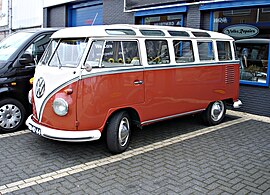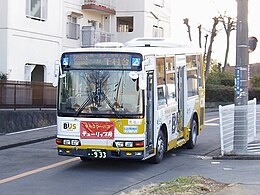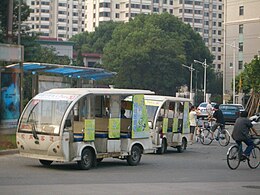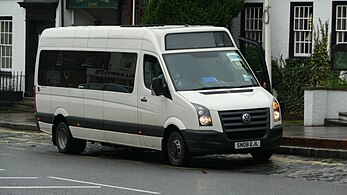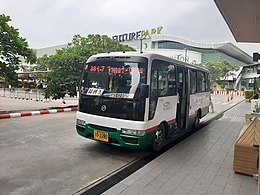Minibus
This article needs additional citations for verification. (February 2023) |




A minibus, microbus, or minicoach is a passenger-carrying motor vehicle that is designed to carry more people than a multi-purpose vehicle or minivan, but fewer people than a full-size bus. In the United Kingdom, the word "minibus" is used to describe any full-sized passenger-carrying van or panel truck. Minibuses have a seating capacity of between 12 and 30. Larger minibuses may be called midibuses. Minibuses are typically front engine step-in vehicles, although low floor minibuses are particularly common in Japan.[1]
History
[edit]It is unknown when the first minibus vehicle was developed. For example, Ford Model T vehicles were modified for passenger transport by early bus companies and entrepreneurs.[2] Ford produced a version during the 1920s to carry up to 12 people.[3][4][5] In the Soviet Union, the production of minibuses began in the mid-1950s, among the first mass-produced minibuses were the RAF-10, UAZ-451B, and Start.[6] Since September 1961, the RAF-977D "Latvia" minibus began to be mass-produced.[7]
Regional variants
[edit]There are many different form of public transportation services around the world that are provided by using vehicles that can be considered as minibus:
- Angkot in Indonesia
- Bas Mini in Malaysia
- Chiva bus in Colombia and Ecuador
- Colectivo in southern South America
- Community bus (Japanese コミュニティバス komiunitibasu) in Japan (Include minibus and midibus)
- Dala dala in Tanzania
- Dollar van a.k.a. jitneys, in the United States.
- Dolmuş in Turkey
- Modern Jeepney in the Philippines
- Maeul-bus (Korean 마을버스) in South Korea
- Marshrutka in eastern Europe.
- Matatu around Kenya
- Minibus taxi in South Africa, Ethiopia, see also Taxi wars in South Africa
- Pesero, minibuses operating as regular buses in Mexico, especially in Mexico City.
- Public light buses, in Hong Kong.
- Sherut in Israel
- Songthaew around Thailand and Lao
- Tap tap in Haiti
- Tro tro around Ghana
- Weyala in Ethiopia
Driving licence
[edit]Some countries may require an additional class of driving licence over a normal private car licence, and some may require a full commercial driving licence. The need for such a licence may depend on:
- Vehicle weight or size
- Seating capacity
- Driver age
- Intended usage
- Additional training (such as the Minibus Driver Awareness Scheme in the UK)
In the UK the following information regarding Minibus driving licences is important: "The holder of an ordinary car driving licence which was obtained prior to January 1997, once aged 21 years minimum, may drive a Minibus with a capacity of 16 passengers. Where the "ordinary car driving licence" is obtained after December 1996, they will have to take a separate test to drive a vehicle with a capacity of more than 8 passengers. However, there is an exemption for certain volunteer drivers, where the vehicle does not exceed 3500 kg GVW (or 4250 kg GVW if the vehicle is designed to be wheelchair accessible). Driving licence source
A driving licence issued in Ontario, Canada, for an equivalent of a UK class B or class B-auto driving licence (in the case of Ontario, a class G licence), allows its holder to drive vehicles with:
- 11 tonnes maximum authorized mass, including trailers with 4.6 tonnes MAM[8] 6 tonnes MAM in certain cases)
- passenger seating capacity of 9 or less
Anyone wanting to drive a vehicle in Ontario, with the same MAM limits as for class G vehicles, with fewer than 25, but at least 10, passenger seats, must obtain a bus licence. This licence will allow, for example, its holder to drive[9] 12- and 15-passenger vans] that Transport Canada defines as large passenger vans.
Gallery
[edit]-
Volkswagen Type 2 "microbus"
-
Russian GAZelle City partially low floor marshrutka
-
A Ford E450 cutaway chassis design, with more integrated bodywork
-
Step equipped van on a converted Toyota HiAce minibus
-
Van converted minibuses as light transit buses
-
Optare Alero integral low floor minibus
-
Van conversion Iveco Daily minibus with full height entrance door
-
Iveco Daily minibus in the UK
-
Mitsubishi Fuso Aero Midi ME low floor minibus
-
Nissan Diesel RN partially low floor light bus
-
Electric minibus in China
-
Mercedes Benz Sprinter minibus in Zihuatanejo, loading passengers for Petatlan and points in between
-
A Volkswagen Crafter minibus
See also
[edit]References
[edit]- ^ Akiyama, Tetsuo; Wahira, Yoshihiro; Kamata, Minoru; Fujii, Naoto (2001). "VEHICLE ACCESSIBILITY IN JAPAN TODAY AND THE OUTLOOK FOR THE FUTURE". IATSS Research. Retrieved 14 November 2024.
- ^ Negyesi, Pal (4 May 2020). "The Role of the Ford Model T As a Bus in Central and Eastern Europe". CEAutoClassic. Retrieved 17 February 2023.
- ^ "Henry the Model T Bus". highfieldspioneervillage.com.au. Retrieved 17 February 2023.
- ^ "1926 Ford Model TT 10 Seater Country Bus Chassis no. 14390021 Engine no. 14390021". bonhams.com. Retrieved 17 February 2023.
- ^ "Car Ford Model T Station Bus 1919 for sale". PreWarCar. Retrieved 17 February 2023.
- ^ Dashko, Dmitry (2013). Юность. Автобус для избранных [Youth. A bus for the elite] (in Russian). ООО "ИПК Парето-Принт". pp. 19–21.
- ^ "Хроника: любимый «рафик»". zr.ru (in Russian). Retrieved 1 July 2024.
- ^ http://www.mto.gov.on.ca/english/pubs/recreational-vehicles/frequently-asked-questions.shtml [bare URL]
- ^ http://www.tc.gc.ca/eng/motorvehiclesafety/tp-tp2436-rs200808-menu-202.htm [bare URL]

